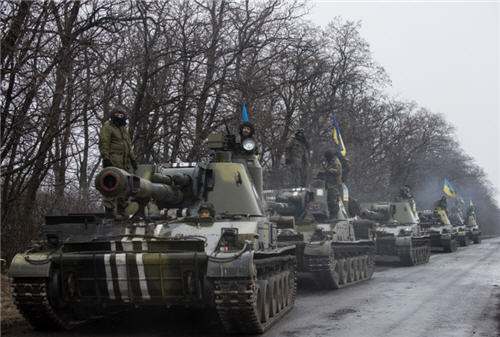 By Gustav Gressell— The Mark News —
By Gustav Gressell— The Mark News —
Despite a ceasefire agreement, fighting in this eastern Ukrainian region simply cycles in its intensity and has never truly ceased. In order to put an end to this two-year-long armed conflict the West needs to support Ukraine’s defence reform and deliver lethal aid.
The flare-up of shelling in the Donbas region of Ukraine this summer, coupled with Russian manoeuvres in Transnistria and increased Russian military deployment to Crimea indicate that war in the Donbas is far from resolved. On Sept. 1, the conflict paused when a new ceasefire regime came into force.
But as with all previous periods of calm in this two-year war when ceasefire agreements were reached, fighting will no doubt flare up again. On such occasions, Western diplomats tend to point to the Minsk implementation agreement – a package of measure intended to alleviate the ongoing war – reached in February 2015, arguing that it must be fully implemented.
However, contrary to conventional wisdom, the Minsk agreement and its provisions neither brought peace – or calm – to the armed conflict in Ukraine’s south-eastern region, nor do its provisions assist in reducing the violence there.
From summer 2014 to summer 2015, the cycles of intensity in the fighting in the Donbas were much more extreme than they are currently. The deployment of Russian forces in the Donbas in the autumn of 2014, led to a Ukrainian defeat at Ilowaisk, while the winter 2015 service rotation of Russian troops led to Ukraine’s defeat at Debalcewe.
After Minsk, another period of calm ensued but did not result in peace, but rather another Russian offensive on the Donbas. New troops were ready to strike by end of May 2015 and by the beginning of June, the fighting for Marinka saw the last major armed assault by Russian forces on a Ukrainian position. The attack, however, was repelled by Ukrainian forces, which by now were much better prepared tactically and more coordinated than before. Additionally, the Ukrainian Army captured several Russian special operation teams, and shot down Russian drones.
What should have been a summer offensive to encircle Mariupol and use the starving city as a bargaining chip to demand more concessions from Kyiv at the negotiating table, turned out to be Ukraine’s first major success in the war. In Russia, the Kremlin was having difficulty hiding the true extent of casualties from the public. The Russian military was not very happy about leading a hidden war, secretly burying the dead, and having no public ceremonies or awards given.
Following Marinka, the Russian army turned its sights on Syria in July 2015. Neither side has attempted to mount another major assault on the other’s position – clear evidence that the Kremlin’s strategic calculations were, above all, responsible for the cycles of conflict and calm.
Since then, the conflict has become a ‘sitting’ war. Most artillery duels have rather profane origins. The Minsk agreement ordered all parties to withdraw heavy weapons from the contact line, according to their range. Both sides rely much more on anti-tank guns for long-range anti-tank duties. If one withdraws anti-tank guns from the front, as commanded by Minsk, the front is particularly vulnerable to armoured assaults.
In fact, many guns are hidden and left in the conflict zone. Any movement by one side that causes suspicion by the other is answered with fire. Most of the time, artillery fire is used as suppressing fire, using nose-fused rounds on entrenched positions – rather than base-fused ones to destroy them. They serve more as a signal to warn the other side, “Hey, I’m here, and I see you,” rather than to kill them.
Mining one’s position is another tactic. The Russian army, has the technical means to clear minefields. But doing so would slow down Russia’s armoured assaults and take time – time needed to rush to the defences.
Diplomatic efforts to de-mine the frontline and ensure a withdrawal of the respective armed forces from the contact line (replacing them with border guards or police forces) will not bring calm to the region but rather increase the feeling of vulnerability and uncertainty. Any weakening of the defences through the Minsk peace accords – be it weapons-withdrawal, de-mining, or troop withdrawal – creates a prisoner-dilemma for each side.
With zero trust between the two sides, no one takes chances. For Ukraine, the dilemma is much more difficult. A military frontline weakened by weapons-withdrawal is a huge risk, but not sticking to Minsk and loosing international support is just as perilous. Hence Ukraine is more cautions and conducts far less ceasefire violations. The Russian proxies enjoy a backup-force by the regular Russian army, hence feel free to engage in escalations on their own, knowing that they will be supported by Moscow. Ultimately, there has effective been no ceasefire.
Such a ceasefire could only be made effective if a military separation force were inserted between the two, not by creating power-vacuums between them.
However, the OSCE has neither the mandate nor the capability to fulfil that role. Any involvement of a peacekeeping force in the region is a tricky diplomatic exercise, as Russia would seize the opportunity to legitimize its own military presence, disguised as peacekeepers – as was the case in Georgia after the 1992 civil war. In fact, only a NATO force could live up to the demand, but any such proposal would be met with stiff resistance in Paris, Berlin and Washington.
Aside from smaller artillery skirmishes, there are phases of larger artillery battles. According to Ukrainian soldiers, one can tell the efficiency and firing discipline of Russian artillery, compared to the “separatists,” as was the case this summer, when shelling by Russian forces with new extended-range munitions into the Ukrainian rear – coincided with Russian intimidation through manoeuvres on Ukraine’s borders.
There are very clear signs that the Kremlin wants to keep up military pressure on Ukraine and the West, and to use the military as leverage at the negotiating table to pressure the West and Kyiv into making concessions.
It is also notable that for the past two years, the fighting intensifies before Ukraine’s Independence Day on Aug. 24. According to Ukrainian sources, Russian intelligence believes Ukraine will launch a large-scale offensive on Independence Day to regain the lost territories.
Having travelled two-thirds of the frontlines in the Donbas around Independence Day, I found no sign whatsoever of a Ukrainian offence. Even more striking, I could travel freely across the entire Ukrainian-controlled part of the conflict zone in the Donbas. Not once did soldiers at Ukrainian checkpoints ask me to take another road, or deny me entry.
If Ukraine had something to hide, this would not have happened. This raises the questions: On what intelligence does the Kremlin base its decisions, and what errors lie ahead with Kremlin policies if it falls prey to faulty intelligence.
Keeping this in mind, the best thing the West can do to reduce tensions and foster peace, stability and security in the Donbas is to support Ukraine’s defence reform and deliver lethal aid – specifically anti-tank guided missiles (ATGM). The reason there currently is relative calm is not due to the Minsk agreement, but because the cost of a major Russian offensive in the Donbas would be too high for Putin to justify to his domestic audience.
ATGM are more precise than anti-tank guns, with much less risk to the civilian population. Unfortunately, the world of diplomatic bargaining is so detached from the military reality on the ground that such measures will likely not come to fruition.
 Dr. Gustav Gressel is a Senior Policy Fellow on the Wider Europe Programme at the Berlin Office of the European Council on Foreign Relations. Before joining the ECFR he worked as desk officer for international security policy and strategy in the Bureau for Security Policy in the Austrian Ministry of Defence from 2006 to 2014 and as a research fellow of the Commissioner for Strategic Studies in the Austrian MoD from 2003 to 2006. He also was committed as research fellow in the International Institute for Liberal Politics in Vienna. Before his academic career he served five years in the Austrian Armed Forces.
Dr. Gustav Gressel is a Senior Policy Fellow on the Wider Europe Programme at the Berlin Office of the European Council on Foreign Relations. Before joining the ECFR he worked as desk officer for international security policy and strategy in the Bureau for Security Policy in the Austrian Ministry of Defence from 2006 to 2014 and as a research fellow of the Commissioner for Strategic Studies in the Austrian MoD from 2003 to 2006. He also was committed as research fellow in the International Institute for Liberal Politics in Vienna. Before his academic career he served five years in the Austrian Armed Forces.





